Description
Save over 25% by buying the Spanish 3 Paired and Group Speaking Activities Bundle. There are 92 Paired and Group activities for Spanish 3 which include LISTENING, SPEAKING, READING, and WRITING activities, PowerPoint dice games, competitions, stations, information-gap tasks, worksheets, and many visuals. Students ask and answer questions, record their partner’s answers, obey prompts, search for items in a Scavenger Hunt, write essays, and complete many other tasks. Google Slides Digital versions are included for 1:1 classrooms and distance learning. Files come in Word, PDF, and PNG for more printing options. All files are editable.
SPANISH 3 PAIRED AND GROUP SPEAKING ACTIVITIES INCLUDE THE FOLLOWING RESOURCES:
COMPARISONS AND SUPERLATIVE / LOS COMPARATIVOS Y EL SUPERLATIVO
- Paired Activity in which students ask and answer questions based on the pictures and record their partners’ answers
- Competition in which students draw the sentences they hear and then answer the questions on whiteboards.
- Superlativo: Group Activity in which students ask questions about members of the group and record their answers.
- Paired Activity in which students running for president and vice-president write an essay explaining why they are as good as their opponents
- Student Handouts explaining the comparisons and superlative of nouns and adjectives, regular and irregular (tan + adjetivos + como; más que; menos que, mayor que, peor que, etc.)
- Student Handouts explaining the comparisons of verbs, nouns, adverbs with four practice activities
STEM-CHANGING VERBS / LOS VERBOS QUE CAMBIAN EN LA RAÍZ
- Activity in which students write sentences, changing the present tense to the preterite tense,
- Alphabetized list of stem-changing verbs
- Student Handout with conjugation charts of, Los verbos que cambian en la raíz demonstrating the use of expressions with the verb, “pensar”
IRREGULAR VERBS / LOS VERBOS IRREGULARES
- Paired Activity in which students ask each and answer questions using irregular verbs, and record their partners’ answers
- 9-slide GO Verbs Paired Dice Game
- Student Handout with verb charts of irregular verbs
REFLEXIVE VERBS / LOS REFLEXIVOS
- Illustrated Paired Activity in which students ask and answer questions based on the pictures, recording their partners’ answers on the sheet using reflexive and non-reflexive verbs (Acuesta vs. Se acuesta, etc.)
- Illustrated Paired Activity in which students ask and answer questions based on the pictures, recording their partners’ answers on the sheet (¿Quién se apura? / ¿Quién se afeita?)
- Competition in which students complete the sentence with the correct conjugation of the reflexive verbs
- Competition in which students complete the sentences choosing the reflexive or non-reflexive verb and writing the correct conjugation
- PowerPoint answers to above competition
- Paired Presentation in which students present a story of their make-believe daily routine, following the instructions, model presentation, rubric for the presentation, grading tally sheet
- Spanish Two Student: Use of the expressions, “Después de / antes de + infinitive” and “Para + infinitive with practice activity
- Spanish Two Student Handout: Conjugation charts / las conjugaciones de los verbos que cambian en la base
- Spanish Two Student Handout comparing the reflexive vs. non-reflexive verbs
- Spanish Three Student Handout explaining the reflexive verbs, comparing reflexive vs. non-reflexive verbs, all the uses and meanings of the pronoun, “se” including, “each other” and the indirect object pronoun and reflexive verbs with special meanings (Me despido de ti vs. Despido al empleado.)
- Spanish Three Student Handout explaining when to use the pronouns, “le” and “les” and comparing the reflexive pronouns with indirect object pronouns (Se cepilla los dientes vs. Le cepilla los dientes a su hermano.)
- Spanish Three Student Handout: Objetos de la rutina diaria / List of objects used in one’s daily routine
- Spanish Three Student Handout: List of 90 reflexive verbs with Spanish and English and examples of verbs used in context (Probarse – Yo me preubo el vestido.)
- 26-slide PowerPoint Jeopardy Game in which students answer questions, complete sentences, and write questions according to the visuals
PROGRESSIVE TENSE / EL PROGRESIVO
- Group Activity / Game: Students ask what someone is doing, say what he/she is doing and mime an activity
- Student Handout demonstrating how to form the gerund including verbs whose base ends in a vowel and the Ir-stem-changing verbs (diciendo, durmiendo) and the placement of object pronouns with the gerund
- Two practice activities in which students write sentences using the present progressive tense and sentences using object pronouns with the gerunds
SER VS. ESTAR
- Paired Activity in which students ask their partners questions using expressions with ser and estar and record their answers (¿Quién es tu mejor amigo? ¿Cómo es? ¿Estás de acuerdo con todas las reglas del colegio?)
- Answers to paired activity
- Competition in which students complete the sentence using either “ser” or “estar” and explain the reason for their choice
- Ser vs. Estar Student Handout: comparison of the meanings of ser and estar with the verbs used in context; uses of both verbs in all verb tenses, explanation of when to use each verb with verbs used in sentences; list of materials (de cuero, de plata); list of common expressions associated with the verbs SER and ESTAR
IMPERSONAL SE / NON-INTENTIONAL SE SE IMPERSONAL Y SE NO-INTENCIONAL
- Paired Activity / Game in which students ask each other if certain activities happen and record their partners’ answers: Students with the most correct answers win.
- Competition in which students change the sentence from active voice to the passive voice. (No vendemos ropa aquí. / No se vende ropa aquí.)
- PowerPoint answers to the competition
- Activity in which students fill in the correct indirect object pronouns and verbs for the non-intentional se (A Jaime ___ ______________ ACABAR el tiempo.)
- Activity in which students make up an excuse for each situation using the non-intentional SE (Miguel no hizo sus quehaceres. Se le acabó el tiempo.)
- Student Handout explaining all the uses of the pronoun, “SE” including the reflexive, each other, indirect object pronoun, impersonal constructions, la voz pasiva, with examples
- Student Handout of impersonal SE and non-intentional SE explaining the structure of passive voice and the SE no intencional and comparing the responsible and the non-intentional sentences
PRETERITE TENSE / EL PRETÉRITO
17 Paired and Group Activities which include LISTENING, SPEAKING, and WRITING activities, competitions, stations, information-gap tasks, and many visuals. Students ask and answer questions, record their partner’s answers, obey prompts, and complete many other tasks. Files come in Word, PDF, and PNG for more printing options. All files are editable.
- Group Competition in which students ask members of their group questions about their past and record their answers.
- Group Competition in which students write on their white boards, changing the sentence from present tense to the preterite tense
- SONG, “Fui Fui Di” that students sing and act out in a presentation
- Rubric for the song
- Paired Activity in which students ask their partners questions using irregular preterite and recording their answers in the third person
- Two Paired Activities in which students ask each other questions and record their partners’ answers according to the visuals using -IR stem-changing verbs
- Paired Speaking Activity and Game in which students try to guess the seven activities their partner did last year
- Competition in which students complete the sentences with the preterite of the verbs, “Dar,” and, “Ver”
- PowerPoint Answers
- Eight Stations Preterite Activity: Students speak Spanish the entire period going from station to station answering questions and receiving points
- Irregular Preterite Bingo / Lotería and -Er and -Ir Preterite Bingo Game
- Scripts for Lotería Games
- Two Paired Activities: Students ask and answer questions about what people are doing and record their partners answers using the preterite of the verb, “hacer” – Visuals aid in comprehension
- Presentation in Pairs: Students choose a set of drawings and describe the scenes in the preterite with some imperfect
- Rubric and necessary vocabulary for the presentation
- 11 Student Handouts on the Preterite Tense (Car / Gar / Zar – Qué / Gué / Cé); Dar and Ver; stem-changing verbs; -IR Stem-changing verbs; conjugation of regular verbs; conjugation of irregular verbs; chart comparing the preterite and imperfect; summary of all preterite
- 26-slide PowerPoint Jeopardy Game of All the Preterite in which students change the sentences from the present tense to the preterite tense
PRETERITE IMPERFECT / EL PRETÉRITO Y EL IMPERFECTO
- Board Game for vocabulary related to the imperfect tense: Students listen to the description or sentence, run to the board, and touch the appropriate word
- Charades and Pictionary competitions: Students act out and draw the sentences they hear.
- Paired Activity in which students read the fairy tale and underline the verbs in the imperfect tense in one color and the preterite tense in another color – introductory activity for recognition of the two tenses
- PowerPoint competition in which students complete the sentences in the story with either the preterite or the imperfect
- Paired Activity in which students answer the questions, then ask their partners the same questions and record their answers using the vocabulary related to the imperfect tense
- Presentation in Pairs: Students choose a set of drawings and describe the scenes in the preterite with some imperfect
- Paired Activity in which students write, “preterite” or, “imperfect” above each verb in the story to indicate which verb tense would be used if the story were told in English
- PowerPoint answers to the above activity
- Paired Activity in which students complete the fairy tale, “Ricitos de oro y los tres osos” by writing in the verbs, either in the preterite or imperfect, then writing their own version of what happened when the bears came home
- Four Student Handouts: Comparemos el pretérito con el imperfecto (Tuve / tenía; pude / podía; quiso / quería; supe / sabía; conocí / conocía); vocabulary list related to one’s childhood, family and imperfect tense
- Song lyrics Ya no quiero por Jesse y Joy
PRESENT PERFECT / EL PRESENTE PERFECTO
- Class competition in which students write and then say a sentence in the present perfect tense
- PowerPoint answers to the competition
- Speed Dating / La cita rápida: Students ask other students in the class what they have done in the past and choose one of the candidates based on their answers
- Group Game in which students say what they have never done
FUTURE TENSE / EL FUTURO
- Paired Essay: Students write a five-paragraph essay about what the future will look like in 25 years (¿Cómo será el mundo en 25 años?)
- Student Handout with verb charts of the future tense, the irregular stems and the four ways of expressing the future in Spanish and how to use the future tense to express probability and wonder
- Paired Game in which students write activities they plan to do in the future and try to guess their partners’ activities
CONDITIONAL TENSE / EL CONDICIONAL
- Paired Game in which students write what they would do if they won a million dollars and try to guess what their partners would do
- El futuro y el condicional Competition in which students change the sentence to the future, then the conditional
- Paired Activity in which students choose from different scenarios to say what they would do in different situations
- Student Handout with conjugation charts of the conditional tense endings; demonstration of the difference of the imperfect (WOULD as in “used to” do something) and the conditional (WOULD as in, if I could); irregular verbs; use of the conditional tense to express probability
- Student Handout and Activities: Students write what they would do in given situations and what people said they would do using the conditional tense
OBJECT PRONOUNS / LOS OBJETOS DIRECTOS E INDIRECTOS
Eight Paired and Group activities which include LISTENING, SPEAKING, AND WRITING activities, PowerPoint dice game, competitions, and many visuals. Students ask and answer questions, record their partner’s answers, search for items in a Scavenger Hunt and complete many other tasks. Files come in Word, PDF, and PNG for more printing options. All files are editable.
These activities include the following resources:
- Dice Game Paired Activity with visuals
- Paired Competition in which students ask their partners questions and the partners answer with double object pronouns
- Paired Activity in which students ask questions using the pronouns, “le” and “les” and record their partners’ answers: ¿Le prestas tu marcador a otro alumno?
- Paired Activity in which students ask which body part is hurting using the verb, “doler” and the pronouns, “le” and “les” and record their partners’ answers
- PowerPoint Competition in which students answer the questions writing or saying the answer with a direct or indirect object pronoun
- PowerPoint Competition in which students write sentences with double-object pronouns
- En parejas – Students answer questions about who does things for them, then ask their partners the questions, recording their answers
- Paired Presentation in which students act out sentences with direct and indirect object pronouns / los complementos / los objectos directos e indirectos
- Rubric for the presentation
- Student Handouts and list of verbs that can be used with direct and indirect object pronouns
PROFESSIONS PAIRED ACTIVITIES
- Activity in which students ask and answer questions based on the visuals
- Competition Game Listening Activity in which students grab the picture that corresponds to the description
DEMONSTRATIVE ADJECTIVES / LOS DEMOSTRATIVOS
- Paired Activity in which students ask and answer questions and record their partners’ answers using demonstrative adjectives
- PowerPoint competition in which students complete the sentences by writing or saying the correct demonstrative adjective or pronoun
- Three Student Handouts on demonstrative adjectives and pronouns
HACE QUE / DESDE CUÁNDO
Students practice proper syntax of the expressions and questions, “hace que / desde hace” and, “¿Cuánto tiempo hace que?” as they read the questions and answers to their partners. Partners must choose or guess the correct answers. Students with the most correct answers wins. Students practice reading, listening, speaking and writing as they ask, answer, and record their answers.
- Paired activity / Game in which students ask their partners questions using the expression, “¿Cuánto tiempo hace que…?” and record their answers.
- Answer Sheet
- Student Handout explaining and demonstrating the expressions, “hace …que, hace un mes, hace una semana, desde cuándo” etc. in the present and preterite
INFORMATION IN THIS ACTIVITY IS BASED ON CURRENT EVENTS AND MAY NEED TO BE MODIFIED TO REFLECT CURRENT HAPPENINGS. (For example, when I created it, Obama was president, so I changed that question to, “Biden.”)
SPANISH PROFESSIONS PAIRED ACTIVITIES
- Activity in which students ask and answer questions about professions based on pictures
- Competition Grab Game in which students read and listen to the description and grab the picture of the profession that matches the description
POSSESSIVE PRONOUNS / LOS POSESIVOS
- PowerPoint competition in which students write sentences using the possessive pronouns
- Possessive Pronoun Student Handout (Es mi lápiz. Es EL MÍO.)
SUBJUNCTIVE / EL SUBJUNTIVO
20 Paired and Group Activities in which students practice the present and imperfect subjunctive
- Paired activity in which students write what their parents and family hope, recommend, advise, suggest, insist on, permit and don’t allow, then ask their partners’ about their families and record their answers (Mis padres insisten en que siempre les diga adónde voy.)
- Mandatos “Tú” Game and activities
- Activity in which students read the passages, underline the imperative in one color and the subjunctive in another
- Cloze for the Song, “A Dios le pido”: Students listen to the song and fill in the missing words
- Al genio le pido: Activity in which students write five requests for the genie in the bottle
- Competition in which students act out the implied commands they hear
- Two dialogues with activities: True / False, complete the sentences (Dudo que…)
- Dialogue Cloze Activity
- ¿Es posible? PowerPoint in which students read the sentences with “Se impersonal” and answer, “Sí” or “No”
- Paired Activity in which students ask their partners certain things are possible or impossible on Mars using the expression, “¿Es posible?” (¿Es posible que la gente viva hasta la edad de 200 años?) Students write complete questions and circle their partners’ answer.
- Competition in which students complete the sentences using the subjunctive or indicative. (Yo hablaré inglés en cuanto la maestra no / mirar
- ¿Cuándo vas a ser feliz? Paired Activity in which students write eight reasons they will be happy in the future and guess what their partners have chosen. (Voy a ser feliz cuando aprenda a hablar español con fluidez.) First person to guess eight reasons wins.
- Las cláusulas adjetivales: Paired Activity in which students write seven caracteristics they are looking for in a spouse and try to guess the seven their partners have chosen.
- Eight Stations Subjunctive Activity: Students speak Spanish the entire period going from station to station answering questions and receiving points
- Art for the placards of the Eight Stations Activity
- Nacimiento de Jesús Paired Activity in which students underline the present subjunctive in one color and the imperfect subjunctive in another color
- Imperfect Subjunctive Paired Activity in which students write what they recommended to their friends last week and ask their partners what they recommended in certain situations (¿Qué le recomendaste al amigo que no quería hacer la tarea? Le recomendé que hiciera la tarea. Pablo recomendó que hiciera la tarea.)
- Imperfect Subjunctive Paired Activity in which students complete the sentences indicating what they would do in each situation, then comment on their partners’ sentences
- PowerPoint competition in which students complete the sentences using the present subjunctive, the imperfect subjunctive, or the indicative
- I Corintios 13: Activity in which students translate the text into English
- PowerPoint answers to above activity
- Group Activity in which students teach the class: Students must include a visual presentation, a practice, a competition, a quiz or assessment and the answers
- Five Student Handouts on the Subjunctive: All subjunctive rules, impersonal expressions, subjunctive with conjunctions of time, adjective clauses, imperfect subjunctive with three activities and PowerPoint answers
GOOGLE SLIDES DIGITAL VERSIONS OF ALL ACTIVITIES for use in Google Classroom, other Google and digital platforms, and distance learning
VOCABULARY BINGO SHEET: Can be used for any vocabulary
To receive free resources, discounts, and notifications of new products, click on the following link to follow my store: ANGIE TORRE
___________________________________________________________________________________________________________________________________________________
OTHER PRODUCTS THAT MAY INTEREST YOU:
Spanish Two Speaking and Listening Paired and Group Activities
Get your students talking with Spanish Three Paired Activities. Spanish Three Paired Activities will lead them to proficiency.
Click here to read about Seven Activities that Guarantee 100% Student Engagement.

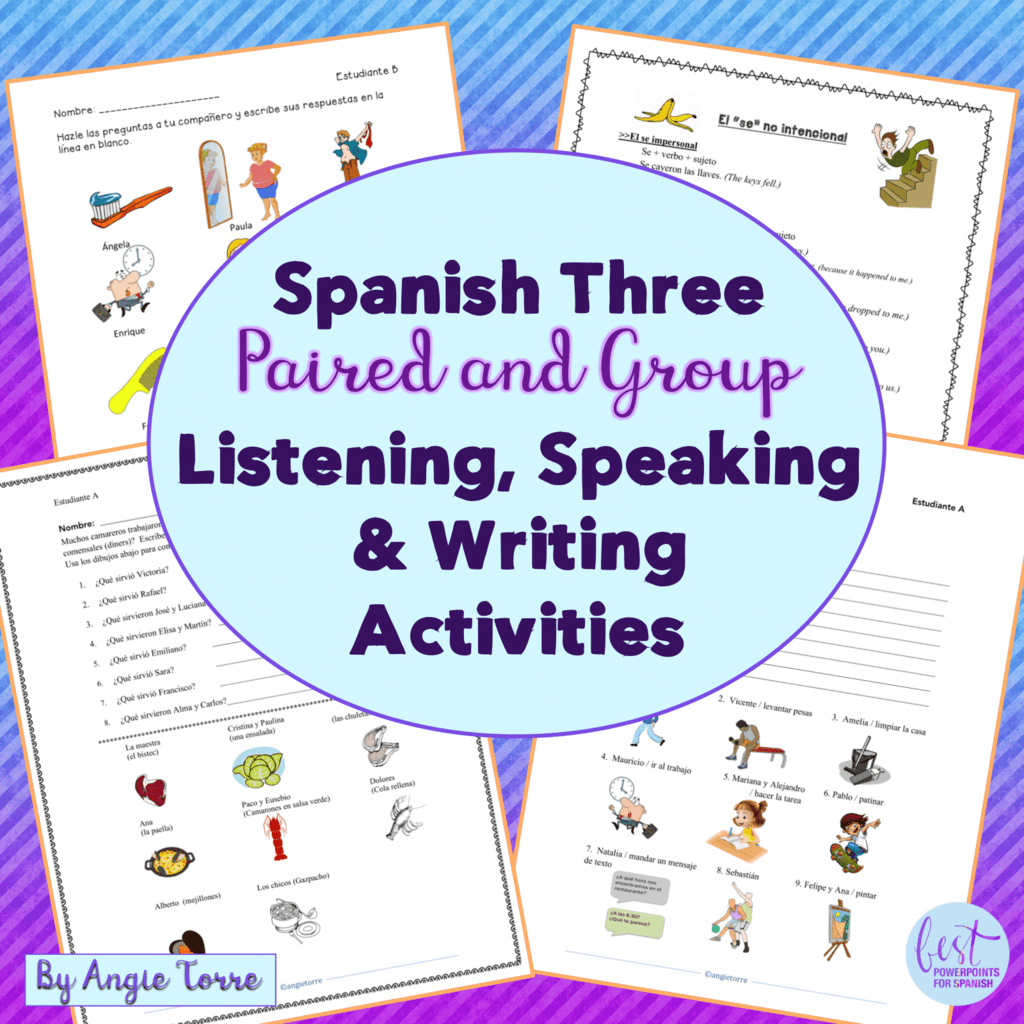
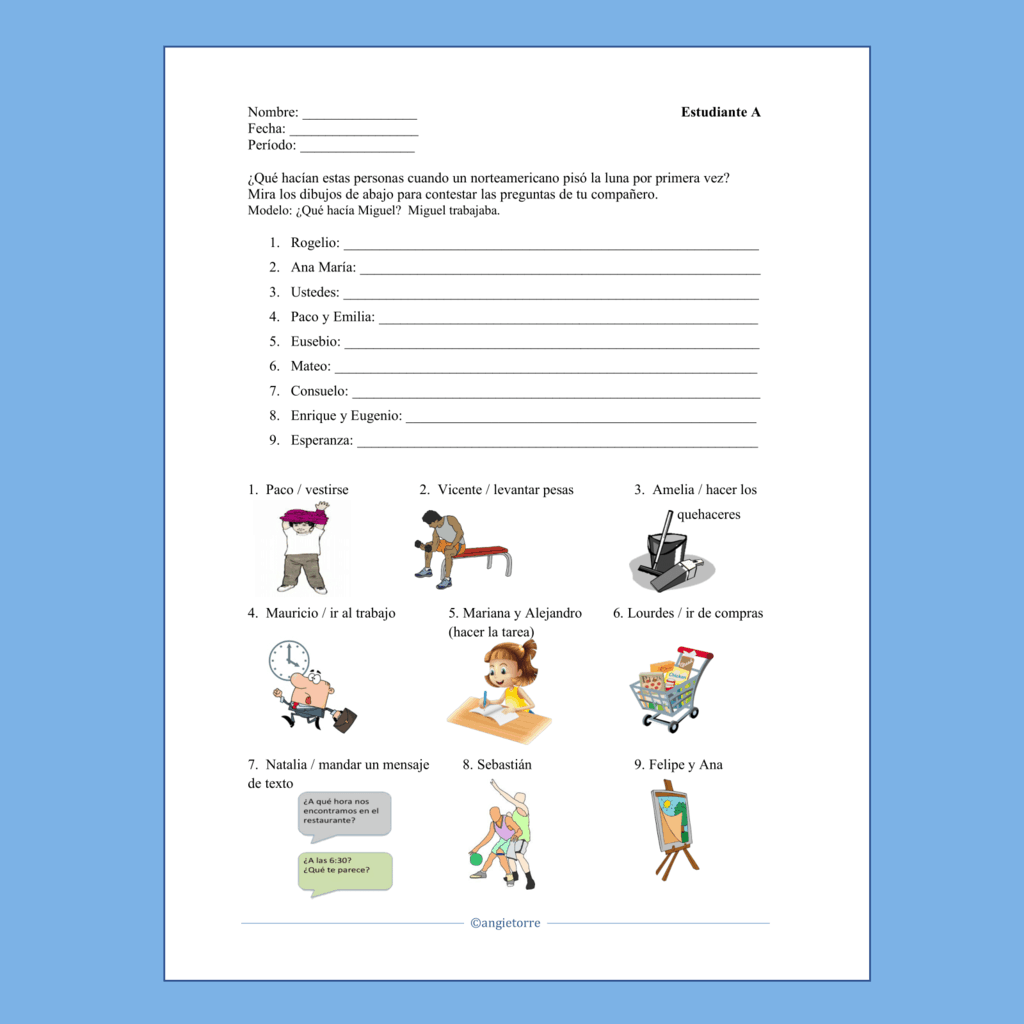

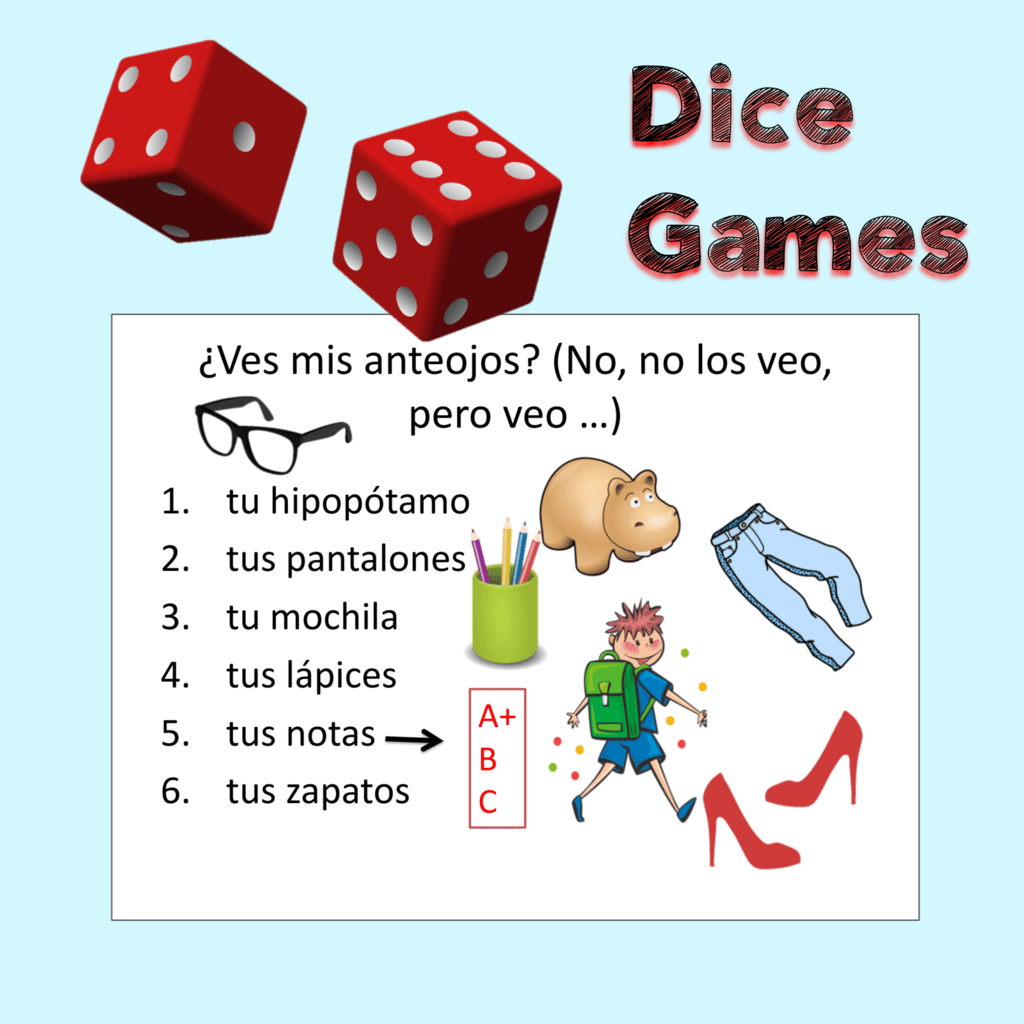

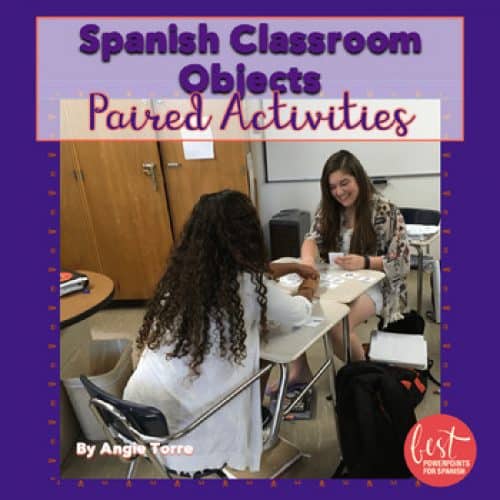
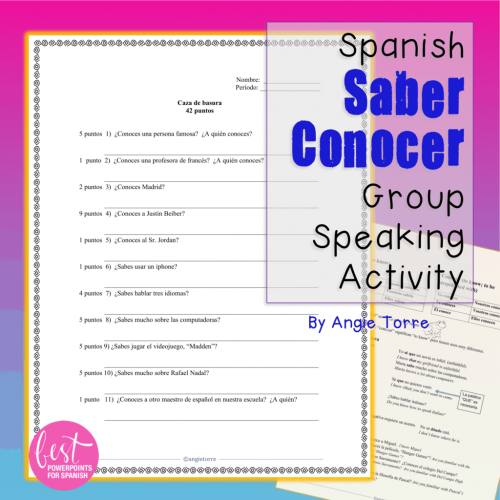
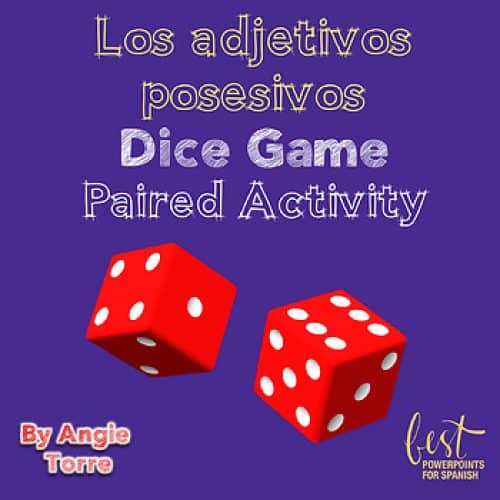
Reviews
There are no reviews yet.